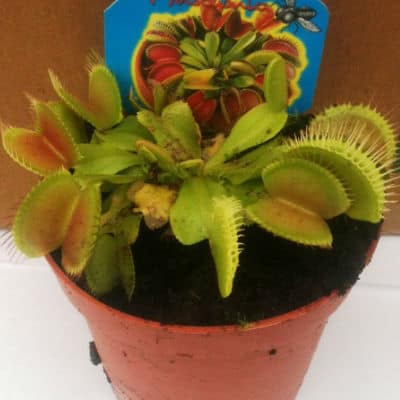Last updated on January 26th, 2022
Our site is reader supported, this means we may earn a small commission from Amazon and other affiliates when you buy through links on our site.
There is something about the mysterious ‘Venus fly trap’. It is also known as the Dionaea muscipula plant. They are great for children as they just love to watch the carnivorous plant catch insects and flies as the red centered traps snap shut, catching their dinner.
They may seem difficult to grow, but with a little help and a few growing tips they are actually quite easy to look after. They originate from the coastal areas of North and South Carolina in America and live in bogs there, so you want to mimic this environment as much as possible.
There is a lot of confusing information online about Venus fly traps so we hope our information will be clear and in ‘plain English’.
How to grow a venus fly trap
In some countries, they can be grown outdoors, but in the UK they need to be grown indoors. They need lots of sun, at least 6-8 hours ideally, so that they can photosynthesize and produce food for the plant. This is also how they get some of the vital nutrients that they store.
It is important to choose a sunny spot on the windowsill and it should be very happy.
How to water a venus fly trap
How you water your Venus flytrap, as well as what you water it with, is incredibly important. It is one of the most common causes of failure for people who try to grow these spectacular carnivorous plants. Firstly, only ever water your plant with distilled water or collected rainwater and use this to water your plant.
It can be tempting to use tap water for convenience, but it usually contains chlorine and other chemicals that are harmful to these sensitive plants. They live in acidic soil in their natural boggy environment. Rainwater is slightly acidic and this is what makes it perfect for using to water your plant.
So start collecting your rainwater now!
Venus flytraps thrive in moist, damp compost, however, be careful not to overdo it because too much water can cause fungus and diseases to attack the roots. Keep the soil moist through the growing season (which is usually around March to October) when your plant will be actively growing.
Venus flytraps go into dormancy for the winter like most plants, although they will still grow a little. When this happens you need to reduce watering, only watering when the soil is starting to become dry. The aim is to let the soil become drier but not completely dry. Begin frequent watering around March when the plant starts to show signs of growth again in spring.
There are two ways to water your plant, the first is to simply water over the top and this is simple enough to do. The second way, (and the way I would recommend) is to place the pot in a saucer or tray filled with water about a couple of inches deep. The compost will soak up the water keeping the soil moist. Some people leave the pot in the water constantly but we would recommend only putting the pot in the water for a few hours at a time when it needs watering.

How to feed a venus fly trap
Venus fly traps can last at least a few weeks without food. We recommend feeding your plant live flies, around once a week if possible. You can feed them dead flies but you will need to stimulate the hairs in the trap to make it close and digest the fly. You want to replicate a live fly so that the trap closes.
Never feed with fertiliser as the nitrogen found in most fertilisers will kill the plants and there is simply no need to feed with them anything other than insects.
Potting on a venus fly trap
Eventually, your Venus fly trap will need potting on into a larger pot. Once the foliage and roots start to look crowded it is time to pot it on, this is usually every few years. Firstly only pot on into a pot that is slightly larger, don’t go too large.
Don’t use normal houseplant compost when potting your plant up, you need to use 50% peat with 50% perlite and mix it together. The perlite helps to retain the moisture and improve drainage. Pot on into either a plastic or glazed pot.
General tidy and pruning of plants
As they go dormant for the winter some of the leaves and traps will start to turn black and die, this is normal and nothing to worry about. Simply remove any of the dead growth and this will make way for new growth in spring, plus removing this dead growth will allow light to reach the new young foliage and promote new growth. Even during the growing season old traps and foliage will die, remove these as and when necessary. Traps usually open and close around 3 times before they die and are replaced with a new trap.
Venus fly trap flower
Venus fly traps produce a white flower upon a tall stem but it isn’t much to look at. It is highly recommended that you remove the flower stalk as soon as you notice it and do not let them flower. Simply cut the flower stalk right down to the base of the plant. The reason for this is that they use up lots of vital energy flowering and often small plants will never recover after flowering and will usually die.
If you are someone experienced in growing Venus flytraps then you may want to try letting them flower and maybe propagating the seed. After flowering, they usually take up to 12 months to recover.
Quick growing tips
- Only water with distilled or preferably rain water.
- Never force traps to close with no food in because this wastes precious energy.
- Feed once a week with live flies if possible.
- Keep soil moist during the growing season but not too wet.
- Reduce watering when they go dormant, around October but don’t allow to completely dry out.
- Grow in sunny spot where it will get at least 6-8 hours of sun indoors.
- Don’t worry about temperature, room temperature is fine but keep it above freezing.



4 Comments
Thanks so much just bought one and then realized I hadn’t the faintest on looking after it . I will definitely recommend this website!
Thanks a lot about the water part i had no clue?
thank you I have learned a lot thankyou
I have just sent for 2 and this information is invaluable thanks